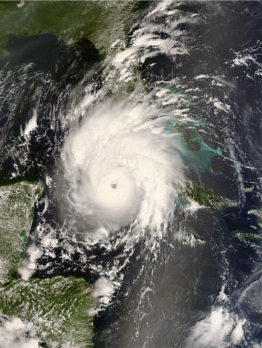Tropical Cyclones
Tropical Cyclones (TCs) belong to the most extraordinary events in nature. On average 40 to 50 TCs with maximum winds of more than 120 km/h are forming each year worldwide (Frank and Young, 2007). Their size, which can exceed 8° in latitude, but also the possible covered distance of up to 10,000 km (only four TCs have been recorded so far with longer tracks) and their enormous maximum wind gusts, which can reach 300 km/h, puts them on the list of the most dangerous events in nature.
Due to increasingly high resolution in numerical modeling, the structure of TCs is increasingly well respresented. This allows for investigating the effect of environmental influences on very realistic TCs. One of these environmental factors is the extratropical influence that is exerted by Rossby waves, either directly by proximity to a TC or indirectly by breaking waves that alter the tropical atmosphere. Other indirect influences may exist, such as downstream effects on the tropical atmosphere, but have yet to be investigated.
For more information, please contact Bernhard Enz ().
References
Frank, W. M. and G. S. Young, 2007: The interannual variability of tropical cyclones. Mon. Weather Rev., 135, 3587–3598, external pagehttps://doi.org/10.1175/MWR3435.1call_made

